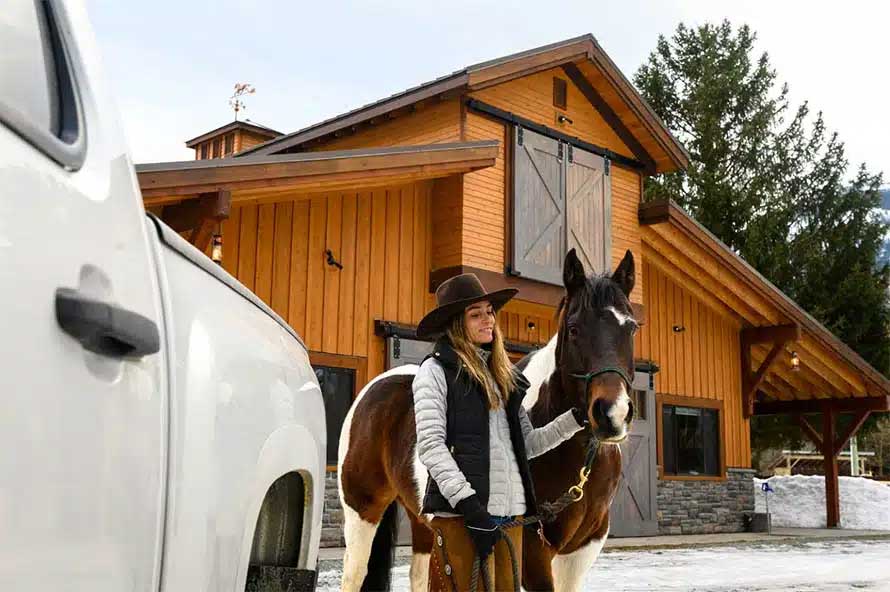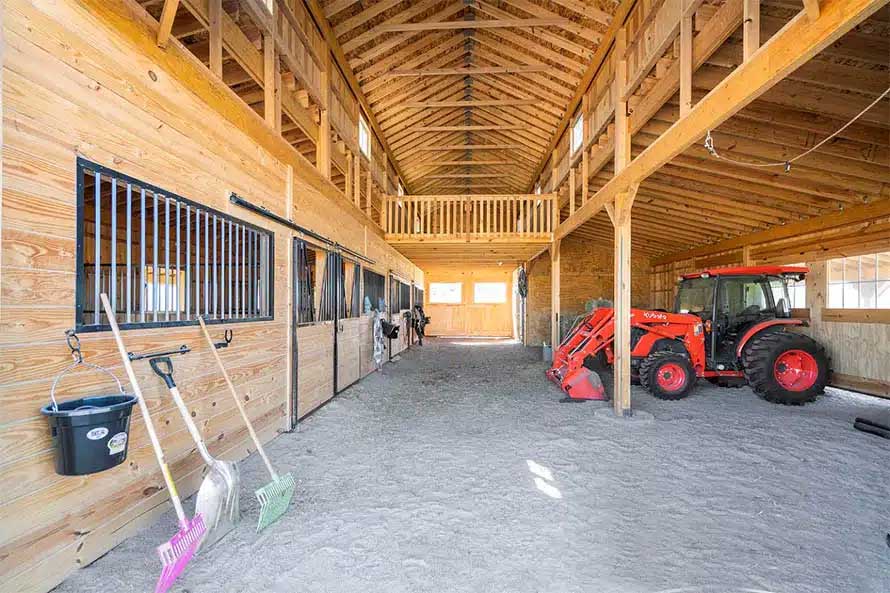Tack & Farm
Our Tack & Farm section features an Apparel section to find both practical and fashionable riding attire. If you ride English & Western or Race, many sources are available in the Tack section.
Building a barn? Need an architect for your equine dream home? Find one in Barns & Stalls.
Have a hungry horse? Of course you do! Find a place to buy your feed and tuck your horse in at night in the Bedding & Feed section. Looking for a place to keep your horse? You can find it in the Horse Boarding section. Keep your horse happy and beautiful with resources in our Grooming section.
Traveling? Find a Shipping company or Horse Sitting service if your horse is staying home!
Running and maintaining a farm or stable is a continuous effort, and to help find products or tools you need, please see our Equipment, Fencing and Management Tools sections.
Seeking Services? Find financial and tax expertise in our Accounting section. Companies who will help protect your investment are found in the Insurance section. For those who want legal advice about purchasing, liability, and other issues, please look at the Equine Law section to find an expert. Build and promote your business with teams from Marketing / Videography / Web Design.
Do we need to add more? Please use the useful feedback link and let us know!

Wanting a new Western saddle but not sure where to start?
Purchasing a new saddle? Excitement, commence! Take a gander at these five helpful Q&As, answered by our friends, Circle Y, to help you in this process. Have more questions? Call or email our Valley Vet Supply saddle experts at saddles@valleyvet.com, and they are more than glad to help.
Are there different kinds of Western saddles?
There are many different types of Western saddles to suit your specific discipline, including saddles made for trail riding, barrel racing, roping, and showing. Learn about the different types of Western saddles produced and the differences in each.
How should riders sit on, or in, the saddle?
A saddle with a 4 ½” or 5” cantle provides a deep, secure seat. A saddle with a 2 ½”, 3”, 3 ½” cantle will feel more open to the rider.
Which saddle seat size is preferred by riders?
Seat size for the rider definitely varies on personal preference and discipline, with seat sizes ranging from 10” (kids) to 18” and half sizes also available. In general, for seat size, you should allow for four inches between the front of your body when you’re sitting comfortably and the swell of the saddle. For speed events and roping, a tighter fit is preferred. For trail riding, sizing a half size up is usually preferred rather than snug.
How much can Western saddles weigh?
Western saddles can range in weight from 20 to 50 pounds, so depending on rider preference and strength, this aspect can be important when purchasing a new Western saddle.
Which saddle tree size will best fit my horse?
Professional saddle fitters are available in the industry to study your horse for a sure fit; however, here are some general guidelines to help you in making this decision.
- Horses with a narrow, defined wither are best suited for a Medium tree
- Horses with a wide, with slightly defined, wither are best suited for a Wide tree
- Horses that are Mutton withered, with a big shoulder, should best fit a Foundation wide
- Horses with a really wide back and wither are best suited for an Extra wide
See a wide selection of saddles and tack available, and for more information, please contact saddles@valleyvet.com.
This article originally appeared on Valley Vet and is published here with permission. Valley Vet Supply was founded in 1985 by veterinarians for people just like you - people who want the very best for their four-legged friends and livestock.
All photos courtesy of Valley Vet.
There are more informative articles in our section on Tack & Farm.

by Nikki Alvin-Smith for Horizon Structures
Old-fashioned horsepower in the vein of equine flesh is a horse aficionados’ favorite type of horsepower to own.
Old-fashioned horsepower in the vein of equine flesh is a horse aficionados’ favorite type of horsepower to own. But alongside the animal variety the machine variety that superseded the horse as a means of transport is a much-needed adjunct to daily life.
Whether it is a vintage car, a daily driver or a work truck, the housing needs for both horses and vehicles has transcended the traditional carriage house design in a horse barn. Or has it?
While keeping machine power with their emissions of noise and gases, flammable fuel and occasional ‘precious’ status protected from the weather in a garage or other building is a great way to provide these ‘beasts of toil’ a safe and secure environment, some horse owners opt to house both types of horsepower under one roof.
Aside from road use vehicles, there are many pieces of farm equipment that can be kept garaged in a handy spot adjunct to the horse barn. ATVs, UTVs, tractors, ride-on lawn mowers etc. This equipment may be fueled by electric, diesel or gasoline. And some safety-first caveats apply to both parking and using this equipment within the confines of any building, but especially one that houses horses and humans under the same roof.
If you decide to build a multi-use structure to accommodate both vehicles and equines it is essential to ensure sufficient fresh air is available in the interior spaces if you plan to run the equipment inside.
Health and safety are of paramount importance in the use of any structure. While there are many great reasons to opt for a combination horse and vehicle structure it is prudent to follow pertinent safety rules in both the construction process, the building design and fire emergency precautions.
That being said, let’s take a look at all the benefits that mixing horsepower housing in one structure can bring to the table.
- Access to the building can be unitized so only one driveway is required.
- A smaller overall footprint may be possible as a result of proximity of horse areas to vehicle parking spaces.
- Electric and water or other service needs can be directed to one building versus two saving money.
- Security/fire suppression systems can be unitized.
- Savings on building purchase expense as construction costs are generally less for one building over two. This is especially true if the company chosen for the project has experience constructing both types of building, and already has necessary supply vendors for materials and the craftsman team (including draftsman) to complete the work on hand.
- A likely shorter timeline for overall build.
- Uniform appearance of unitized building.
- Less cost for site preparation.
- Certain construction companies have experience in building both barns and garages, which is an obvious advantage if you are purchasing a multi-use building.
While many horse barns are already designed equipped with overhead doors, similar style windows and hardware, that you would find in a garage build, so adding a garage space is not a huge ask, design wise there are many extra details you find in a garage that need to be addressed. For example, the flooring requirements and thus site prep required to handle the weight of a vehicle may be substantially different when it comes to concrete strengths and ground height access of the entranceway than an area designed for horses.
The height requirements for doorways to accommodate equipment with roll bars or cabs such as larger tractors may require elevation of a usual barn building framing plan.
If you can utilize a company for the multi-use build that has experience in combining vehicles/equipment and horse housing, then they likely have the drafting skill talent on staff to properly orchestrate the plans required to accommodate both needs.
Melding the horse barn with garage space offers a neat way to house a truck and horse trailer, even allowing horses and show supplies to be loaded under cover. It is very useful to be able to garner access to the horse trailer during winter weather, without the need to dig it out of a snowbank.
When it comes time for loading and unloading horses, the interior space can be properly matted with a non-slip material to make the process simple to execute at all times of day and night. When the new horse arrives after a long journey or you return home late from a busy weekend showing, being able to back in to a well -lit area for unloading is a boon. Many professionals use their indoor arenas for the purpose of loading and unloading the trailer, and these larger buildings allow plenty of space to maneuver the rig. If you are utilizing a garage option, think carefully about how open plan the space will need to be to avoid costly damage moving any equipment about inside.
If you do park a tractor with a loader or bucket attachment, be careful not to inadvertently lift the bucket too high when picking it up off the floor to engage the tractor to move. Similarly, the bed of a pick-up stuffed high with a load of hay may be conveniently close to where it will be stacked inside the barn, but don’t forget to allow for the extra height of the load.

Significant savings on the trim and all exterior products including smaller items such as guttering can be enjoyed with a combination barn/garage, and site preparation costs are likely to be less to level and compact/prepare a concrete pad etc. for one area versus two, depending on the terrain and purpose of the structure.
Read more: Horses and Vehicles – The Practicalities of Mixing Horsepower Housing
Follow these tips to ensure the proper fit when selecting a blanket or fly sheet for your horse.
- Julie Goodnight: Talks About Saddle Fit with Darrell Nephew of Circle Y Saddles
- Dual Barns Mean Dual Customer Base
- How To Manage Horse Barn Needs After Catastrophe Strikes
- Equitopia - What to Expect in a Saddle Fit Evaluation (5:16)
- Barn Design and Management Tips For Competition Horses
- Difficult Horses. Difficult Boarders
- To Fence or Not to Fence? That Is the Question
- The Art and Heart in Timber Frame Horse Barns and Pavilions
- Working Saddles for Working Horsemen
- Don Gonzales: Riding the Wave of Social Media
































